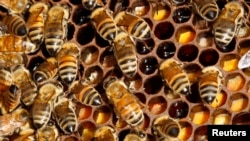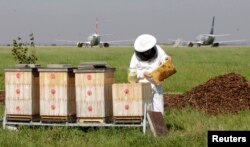For about a decade, scientists have been investigating a class of pesticides called neonicotinoids as one of the culprits behind the worldwide loss of domesticated honeybees. Now, a pair of new studies has people on both sides claiming victory.
Neonicotinoids, or neonics, were developed in the 1980s and '90s and became one of the most widely used insecticides. Recently, however, there has been concern about its effect on honeybees. Roughly one-third of the world's crops benefit from pollinators like honeybees.
Studies in the lab have shown inconsistent effects of neonics on bees. Amro Zayed, a biologist at York University in Toronto, says that could be because bees aren't exposed to the same levels of neonics across studies.
"People criticize these experimental studies by saying that the authors used too much neonicotinoids or they treated bees to neonicotinoids for a much longer period of time than would be found in the field," Zayed said.
Zayed tried to address that question in the first of the two studies published in the journal Science. It focused on how much of the pesticide bees were exposed to in the fields. In Canada, neonics are coated onto corn and soy seeds and spread throughout the plant as it grows. The bees pick it up in the pollen.
The researchers studied six sites near cornfields.
"We tracked them for the whole season. And we were able to monitor the neonicotinoids coming into the colony," Zayed said.
The researchers found that the bees brought in pollen tainted with neonics for as long as four months beyond the growing season — much longer than they had expected. They also examined the pollen to determine from which plants it was collected.
"And what we found was a big surprise," Zayed said. "There was actually almost no pollen coming from corn and soy."
This means that the pesticide was being washed away from cornfields and absorbed by other plants. Zayed warns that these neonics probably will stay in the environment for several years.
The researchers then exposed bees in the lab to the same level of neonics found in the field. That shortened the life span of worker bees by 25 percent.
Conflicting results
In the second study, researchers from the Center for Ecology and Hydrology in England monitored hives at 33 fields across the United Kingdom, Germany and Hungary in one of the largest such studies.
They found that neonics generally hurt colony health in the U.K. and Hungary. However, in Germany, the neonics had some positive effects on bees. For example, the count of egg and larval cells was elevated in Germany, while it was reduced in Hungary and unaffected in the U.K.
Researchers point to the local environment to explain the difference. Germany had more flowers by the fields, perhaps providing the bees with a better food source. This variable could explain why some studies have shown negative effects, while others show positive ones.
The European study was funded by two neonic producers, Sygenta and Bayer CropScience. They also manufactured the neonics used in the study.
Sygenta scientist Peter Campbell noted that the vast majority of variables in the study appeared to be unaffected by the neonics. He said that the beneficial findings cast doubt on the results.
"I do struggle to rationalize a positive beneficial effect of an insecticide on honeybees," Campbell said. "And so, therefore, my next worry is: Is that a real positive effect? And if the positive effects aren't real, I then worry about the negative effects."
Campbell said that the alternatives to neonics are far less effective.
The result, then, is that there is still no consensus on what role neonics play in the deaths of honeybees, nor what impact ending their use would have on agriculture.










